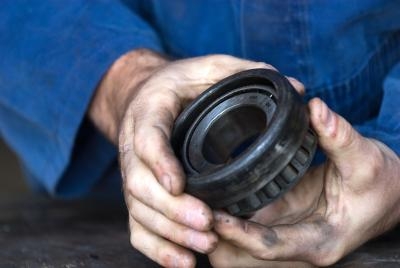
The average shop has all kinds of greasy parts lying around, and a pro shop might well be filled wall-to-wall with grungy old cylinder heads and engine blocks. Whether your aim is to manufacture a DIY parts washer to rebuild your own engines or those of others, a pro-level parts washer can make the whole process much easier and will help to turn out results that you can be proud of. The washer can be as simple or as complex as you need it to be, depending on your needs and budget.
Place your 55-gallon drums next to each other, standing up side-by-side, and tack-weld the rims together to keep the drums from moving. Cut four lengths of 2-by-2-inch square steel tubing: two lengths measuring 24 inches and two more measuring 52 inches. Cut four identical pieces from the stainless 2-by-2.
Clamp the two short pieces of standard steel tube to the ends of your barrel assembly, and use a long section to get them even with the back of the barrel assembly. Tack-weld the short pieces in place, then weld the 52-inch piece to the barrels and the ends of the short pieces. Repeat this procedure on the other side of the barrels to create a rectangular frame around the tops of the barrels.
Set your pieces of stainless tubing on top of the barrel frame in the same position as the barrel frame pieces, and weld the the stainless sections together to create a matching rectangular frame for the bottom of the sink. Drop the sink into this stainless frame and fit the frame to the bottom of the stainless steel sink; you may need to fabricate a few shorter pieces of stainless steel to act as brackets and connect the frame to the sink. Finish welding the barrel frame to the barrels.
Cut out a set of flat filler plates to fill the gaps between the barrel frame and the barrels, as well as the gaps between the sink frame and the sink. Set the sink/frame assembly on top of the barrel/frame assembly and bolt a set of hinges on the left-hand side of the sink. When you're done, the sink will act as a lid for the barrels and hinge upward to expose them. Double-check your filler-plate welds.
Drop the sink/lid back down on top of the barrels. Now fabricate your fluid-circulation system. There are a number of ways to do this, but the basic principle involves dropping a length of fuel line down through the sink drains and into the barrels so that the lines lay in a coil around the bottom of the barrels. Fabricate an oil filter mount near the hinge on the barrel frame, and connect the feed lines to the filter.
Install a length five-foot length of fuel line onto the oil filter's line nipples and route it to the bottom-outside of the barrel. Mount your fuel pump to the bottom-outside of the barrel; Fuel pumps are far better at pushing fluid than pulling it, so mounting the pump low will help to prolong its lifespan. Attach a 10-foot length of fuel line to the pump and use a hose clamp to hold it in place.
Plug a 1-foot length of steel tubing into the end of the fuel line. Crimp the end of the steel fuel line with a pair of pliers; this will increase the fluid pressure exiting the line and make your washer more effective. Connect the fuel pump's power supply wires to a 12-volt power source.